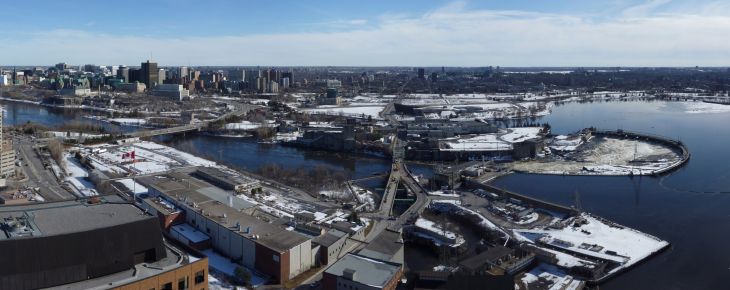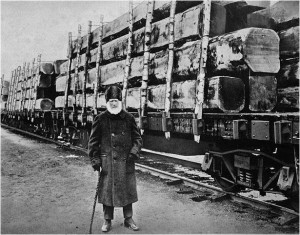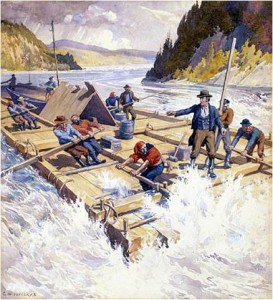

Every heritage building and vestige of the past in the Victoria-Chaudière Islands area has a tale to tell about the history of the area and the country. But none is more compelling than the stories of the Canadian industrial pioneers whose work at the Chaudière helped shape the development of the nation and the Nation Capital.
These incredible entrepreneurs forged an era of industrialization and prosperity with their strong character, extreme hard work and world-class creativity, innovation and competitiveness.
Trailblazers
Wright & By
In terms of Industry, Philemon Wright started it all at the Chaudière. His family pioneering fortitude paved the way for the rest. Milling and timber trades were profoundly boosted by Wright and his legacy.
Even before his work began on what was to become the truly significant Rideau Canal, superintendent Colonel John By performed a major engineering feat by spanning the wide channel over the Chaudière Falls in 1826-28. Connecting Upper and Lower Canada, the Union Bridge was the first in a succession of bridges at this location (to the present Chaudière truss bridge of 1919) and had momentous impact on development in the region.
J.R Booth
John Rudolphus Booth came to the Chaudière from Quebec’s Eastern Townships in 1852. A poor carpenter, he worked for the Wrights on the side, making shingles at night. Eventually, he rented a small mill, producing laths from scraps. Soon, he had saved enough to purchase the Thompson Perkins Mill (1842, now The Mill Restaurant) and then in 1857 purchased the huge Egan timber limits in the

J.R. Booth, Source: Library and Archives Canada, C-046480
Upper Ottawa Valley. When he won the 1859 contract to provide much of the lumber for the New Parliament Buildings, his success was assured. By the time of his death in 1926 at the remarkable age of 98, he remained in complete sole control (no board of directors or shareholders) of a truly mammoth lumbering and railroad empire. It was said he was the wealthiest citizen in the Dominion; all built on the strength of his early Chaudière mills.
E.B. Eddy
Ezra Butler Eddy arrived at the Chaudière form Vermont in 1854, and rented part of the old Wright smithy where his wife would band-dip scrap lumber shards into a toxic sulphite solution -making matche
s. A “born salesman”, Eddy very successfully peddled these matches by horse and buggy. Rapidly expanding, he diversified into household wood products, then later purchased timber limits and began milling. By late in the century, Eddy had pioneered the shift from squared timbers to sawn timber to pulp and paper. He also built the first vertical sulphite wood-chip digester in North America – the high technology of the day. The stone tower that housed the metal pressure vessel, said to be the tallest building in Canada at the time, still stands today (on the grounds of the Museum of Civilization, directly across from the Parliament Buildings), along with a number of other Eddy mill buildings in the area, preserved as a tribute to this legendary figure of the Chaudière.
Bronson Family, Inc.
In the 1850s, a handful of well-connected American industrialists moved north to mill forest resources at the Chaudière. These included Captain Levi Young, W.G. Perley, C.B. Pattee and Henry F. Bronson, an early purchaser of water rights and the first to establish a major saw mill, in 1852, expanded his Victoria Island operation step by step to become producer of about a quarter of the massive output at the Chaudière in the early 1880s. In 1889, he handed the highly integrated family empire over to his son, Erskine H. Bronson, who diversified the assets into pulp and paper, hydroelectric utilities, transportation, minerals, chemicals, gas lamps and heaters. This corporate approach, together with Bronson’s entrenchment into the City’s social, financial and political power structures, contrasted with the previous Chaudière “lumber baron” mentality and protected assets from market volatility. In hindsight, this was a brilliant strategy, given the shifting patterns of natural resources and political decisions.
The Bronson Company whose former head office remains today on Middle Street, Victoria Island, was instrumental in most major economic developments in the Capital in the late 19th century and early 20th century, Including:
- The Ottawa Power Company and the Standard Electric Company, which later amalgamated with others evolving into the power utilities responsible for Powerhouses #2 and #4 on Victoria Island, which ushered in the age of electricity in the Capital and still produce some of the City’s power today – enough for 12,000 homes.
- The Ottawa Electric Railway Company, which amalgamated to form the early transit outfit that replaced the horse and wagons, was the first to run cars with night lighting and heating and even pioneered street cleaning and snow removal with these electric streetcars.
- In partnership with inventors Thomas Ahearn and Warren Soper, two other key industrial-age figures of the Chaudière, Bronson constructed some of the largest electrical works in Canada. Ahearn, who was born in Ottawa in 1855, also invented the electric stove and produced the first nation-wide radio broadcast.
 Wordpress
Wordpress






